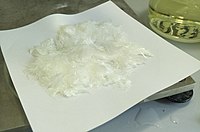
Photo from wikipedia
The adsorptive behavior of clinoptilolite (Cpt) zeolite in its raw and nickel-exchanged form towards m-xylene/p-xylene/ethylbenzene unary, binary, and ternary mixtures was investigated. The motivation behind the research was to elucidate… Click to show full abstract
The adsorptive behavior of clinoptilolite (Cpt) zeolite in its raw and nickel-exchanged form towards m-xylene/p-xylene/ethylbenzene unary, binary, and ternary mixtures was investigated. The motivation behind the research was to elucidate whether Cpt in its raw or ion-exchanged form could exhibit distinctive selective adsorption behavior. The natural Cpt (Si/Al atomic ratio = 4.59) was ion-exchanged twice with 0.5 M Ni(NO3)2 solution at 80°C for 6 h. Adsorption experiments were done at 40°C, using a 4 vol.% solution of the aromatic materials in iso-octane. The maximum amount of the total specific adsorption capacity for binary solute systems was ~0.8 and ~2.0 mmol g–1 for the raw and ion-exchanged Cpt, respectively. For the ternary solute systems, unexpectedly, this capacity increased to ~2.0 and ~3.0 mmol g–1, respectively. For binary mixtures, both forms of Cpt were selective for p-xylene. For ternary mixtures, both forms exhibited a clear selectivity for m-xylene but the Ni-exchanged Cpt was significantly higher over the concentration range studied. The unexpected increase in the adsorption capacity in ternary systems was attributed to the expulsion of tightly bound trace water molecules hindering the access of xylene molecules to the 10-member ring channels of the zeolite framework. Substitution of Mg2+ by Ni2+ in the 10-member ring channels enhanced the adsorption capacity by providing more space and stronger electrostatic interactions between the new cation and the polar m-xylene molecule.
Journal Title: Clays and Clay Minerals
Year Published: 2020
Link to full text (if available)
Share on Social Media: Sign Up to like & get
recommendations!